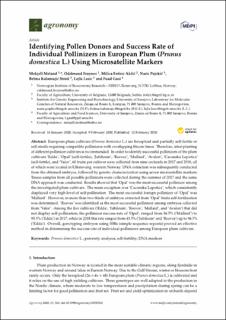| dc.description.abstract | European plum cultivars (Prunus domestica L.) are hexaploid and partially self-fertile or self-sterile requiring compatible pollinizers with overlapping bloom times. Therefore, inter-planting of different pollinizer cultivars is recommended. In order to identify successful pollinizers of the plum cultivars ‘Edda’, ‘Opal’ (self-fertile), ‘Jubileum’, ‘Reeves’, ‘Mallard’, ‘Avalon’, ‘Cacanska Lepotica’ (self-fertile), and ‘Valor’, 60 fruits per cultivar were collected from nine orchards in 2017 and 2018, all of which were located in Ullensvang, western Norway. DNA extraction was subsequently conducted from the obtained embryos, followed by genetic characterization using seven microsatellite markers. Tissue samples from all possible pollinizers were collected during the summer of 2017 and the same DNA approach was conducted. Results showed that ‘Opal’ was the most successful pollinizer among the investigated plum cultivars. The main exception was ‘Cacanska Lepotica’, which consistently displayed very high level of self-pollination. The most successful foreign pollinizer of ‘Opal’ was ‘Mallard’. However, in more than two thirds of embryos extracted from ‘Opal’ fruits self-fertilization was determined. ‘Reeves’ was identified as the most successful pollinizer among embryos collected from ‘Valor’. Among the five cultivars (‘Edda’, ‘Jubileum’, ‘Reeves’, ‘Mallard’, and ‘Avalon’) that did not display self-pollination, the pollinizer success rate of ‘Opal’, ranged from 36.5% (‘Mallard’) to 93.5% (‘Edda’) in 2017, while in 2018 this rate ranged from 43.5% (‘Jubileum’ and ‘Reeves’) up to 96.5% (‘Edda’). Overall, genotyping embryos using SSRs (simple sequence repeats) proved an effective method in determining the success rate of individual pollinizers among European plum cultivars. | en_US |

